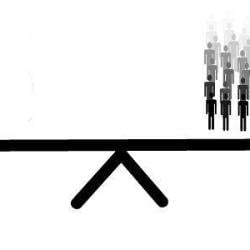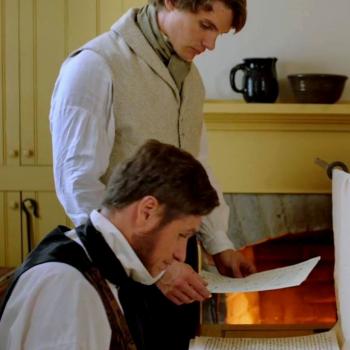By Sian Gibby -- June 16, 2009
Photo by davethegrey
 If you type the word "rabbi" into a Google Image search, the first page will show precisely one image of a female rabbi, one image of a cat dressed as a rabbi, and a cartoon of a penguin dressed as a rabbi. The rest of the pictures display a kind of a stereotype, of which this guy is pretty representative.
If you type the word "rabbi" into a Google Image search, the first page will show precisely one image of a female rabbi, one image of a cat dressed as a rabbi, and a cartoon of a penguin dressed as a rabbi. The rest of the pictures display a kind of a stereotype, of which this guy is pretty representative.
American Jews retain some societal expectations about a rabbi's appearance, expectations rooted in cultural history. Religious men--rabbis or otherwise--have worn the kind of "uniform" Google Images represent: beard, dark suit, kipa (skullcap), tzitzit (a fringed undergarment), and a tallit (prayer shawl). The uniform for an Orthodox Jewish woman might include longer sleeves and skirts; covered hair or a wig. But what does a religious, modern, liberal Jewish female rabbi wear?
(When we talk about women who are rabbis, we by definition exclude Orthodox women. Orthodox seminaries ordain only men; whereas Judaism's more liberal movements allow women and men to become rabbis. The Reform movement ordained its first woman rabbi in 1972, the Reconstructionists in 1974, the Conservative movement in 1985.)
Male rabbis of every stripe can easily don a dark suit and kipa and look the part. In recent years, with more and more women becoming rabbis, how they express themselves, via their clothes, as authority figures has become something of a point of concern. In a 1999 New York Times article on clergy and dress, Rabbi Mychal Springer attributed public discomfort about women rabbis and dress to repressed fears of sexuality. She and others report being admonished for modes of dress that hinted, even obliquely, at the feminine body underneath.
Ten years on, the equality of the sexes having advanced apace, the threat of sexuality seems less at issue. The female rabbis interviewed for this story (all of them congregational or pulpit rabbis), Reform and Conservative, East Coast and West, newly ordained or veterans, mentioned being concerned first and foremost with conveying appropriateness. It's a subtle but significant shift. These rabbis aren't worried about offending anyone by looking sexy. They want most of all to avoid any look that might distract from them doing their job. In fact, most said that although they wear suits when required (weddings and funerals), they refuse to compromise their femininity.
Rabbi Esther Lederman -- recently ordained at Hebrew Union College and a rabbi at Temple Michah in Washington, D.C. -- said, "Some of the first women rabbis I met ... just made me think, ‘I don't want to be a man.' So, I will wear a suit, but I'll wear it with heels. It's a weird balance, because you don't want to be in a uniform. You want to blend in. You don't want anything you're wearing to be distracting. If I dressed like a man, it would be unappealing to people."
One traditional signal linked with the rabbinate is the kipa. Many of the rabbis interviewed said they experimented with wearing one but finally opted not to (even in synagogue) specifically, in part, because the kipa is traditionally such a masculine piece of clothing. Rabbi Felicia Sol (ordained at HUC in 1999 and one of three rabbis at Manhattan's non-denominational Congregation B'nai Jeshurun) said, "I don't want to wear a kipa to tell people I am a rabbi. ... A kipa is to remind me about God, not to tell other people who I am. I also feel that for women to be understood in religious terms, whether it's as a rabbi or an observant person, we shouldn't have to become men. And so I have an ambivalence about wearing [a kipa] in order to gain acceptance."
All the rabbis spoke about congregants remarking on their appearance. "People are always commenting on your clothes or your hair," Rabbi Sol said wryly. "There's a perception that there's more permission to make that a topic of conversation. No one will come [to synagogue] on Shabbat morning and say to one of the male rabbis, ‘Great haircut!' But they will to me. I am not really sure what it's all about, but we laugh about it."
Rabbi Rachel Ain, who received her ordination from the Conservative Jewish Theological Seminary and who is the rabbi at Congregation Beth Sholom-Chevra Shas in Dewitt, NY, recalled an evening when her outfit raised eyebrows. JTS Chancellor Arnold Eisen gave a lecture at her synagogue, and Rabbi Ain decided to buy a new dress for the occasion and used a little more make up than usual. "I cannot tell you how many people said, ‘Oh, Rabbi, you look so beautiful tonight, you're glowing,'" she laughed.
Compliments aside, these rabbis stress the importance of looking correct. Rabbi Heather Ellen Miller of Temple Beth El of South Orange County said, "I try to do what is appropriate for my time and place," adding, "Since I am at Temple a lot, I try to wear functional, respectful clothing. I appreciate rabbinic clothing when it is not distracting. People should wear clothes, clothes shouldn't wear people. This goes for both female rabbis and male rabbis. The most successful rabbis know their communities and what's appropriate."




